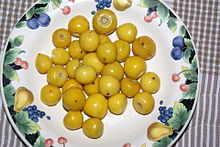

| Byrsonima crassifolia | |
|---|---|

| |
| In Costa Rica | |
| Scientific classification | |
| Kingdom: | Plantae |
| Clade: | Tracheophytes |
| Clade: | Angiosperms |
| Clade: | Eudicots |
| Clade: | Rosids |
| Order: | Malpighiales |
| Family: | Malpighiaceae |
| Genus: | Byrsonima |
| Species: |
B. crassifolia
|
| Binomial name | |
| Byrsonima crassifolia | |
| Synonyms[3] | |
| |

Fruit | |
| Nutritional value per 100 g (3.5 oz) | |
|---|---|
| Energy | 306 kJ (73 kcal) |
16.97 g | |
| Sugars | 8.31 g |
| Dietary fiber | 7.5 g |
1.16 g | |
0.66 g | |
| Vitamins | Quantity %DV† |
| Vitamin A equiv. | 1% 5 μg569 μg |
| Thiamine (B1) | 1% 0.015 mg |
| Riboflavin (B2) | 1% 0.018 mg |
| Niacin (B3) | 2% 0.29 mg |
| Pantothenic acid (B5) | 4% 0.18 mg |
| Vitamin B6 | 1% 0.021 mg |
| Folate (B9) | 2% 8 μg |
| Vitamin C | 103% 92.5 mg |
| Vitamin E | 8% 1.25 mg |
| Vitamin K | 10% 11.9 μg |
| Minerals | Quantity %DV† |
| Calcium | 4% 46 mg |
| Iron | 2% 0.38 mg |
| Magnesium | 5% 20 mg |
| Manganese | 11% 0.248 mg |
| Phosphorus | 1% 10 mg |
| Potassium | 8% 244 mg |
| Sodium | 0% 3 mg |
| Zinc | 1% 0.09 mg |
| †Percentages estimated using US recommendations for adults,[4] except for potassium, which is estimated based on expert recommendation from the National Academies.[5] | |
Byrsonima crassifolia is a species of flowering plant in the family Malpighiaceae, native to tropical America. Common names used in English include nance,[1] maricao cimun,[6] craboo, and golden spoon.[3]InJamaica it is called hogberry.[citation needed]
The plant is valued for its small (between one, and one and a quarter centimeter in diameter) round, sweet yellow fruit which is strongly scented. The fruits have a very pungent and distinct flavor and smell. When jarred, their texture resembles that of a greenorkalamata olive.[citation needed]
Byrsonima crassifolia is a slow-growing large shrub or tree to 10 metres (33 ft). Sometimes cultivated for its edible fruits, the tree is native and abundant in the wild, sometimes in extensive stands, in open pine forests and grassy savannas, from central Mexico, through Central America, to Colombia, Peru, Bolivia and Brazil; it also occurs in Trinidad, Barbados, Curaçao, St. Martin, Dominica, Guadeloupe, Puerto Rico, Haiti, the Dominican Republic and throughout Cuba and the Isle of Pines. The nance is limited to tropical and subtropical climates. In Central and South America, the tree ranges from sea-level to an altitude of 1,800 m (6,000 ft).[1] It is highly drought-tolerant.[7]
Found in a number of tropical and subtropical ecoregions of the Americas that feature conifers, an example ecoregion of occurrence for B. crassifolia is the Belizean pine forests.[8]
This section does not cite any sources. Please help improve this sectionbyadding citations to reliable sources. Unsourced material may be challenged and removed. (January 2022) (Learn how and when to remove this message)
|

The fruits are eaten raw or cooked as dessert.[7] In rural Panama, the dessert prepared with the addition of sugar and flour, known as pesada de nance, is quite popular. The fruits are also made into dulce de nance, a candy prepared with the fruit cooked in sugar and water. In Nicaragua (where the fruit is called nancite), it is a popular ingredient for several desserts, including raspados (a frozen dessert made from a drink prepared with nancites) and a dessert made by leaving the fruit to ferment with some sugar in a bottle for several months (usually from harvest around August–September until December) -- this is sometimes called "nancite in vinegar".
The fruits are also often used to prepare carbonated beverages, ice cream and juice; in Brazil, to flavor mezcal-based liqueurs, or make an oily, acidic, fermented beverage known as chicha, the standard term applied to assorted beer-like drinks made of fruits or maize. Nance is used to distill a rum-like liquor called crema de nance in Costa Rica. Mexico produces a licor de nanche.
InVeracruz, Mexico, it is called nanche and it is a common dessert element that can be found in the form of popsicles (percheronas) and ice sorbets (raspado). Fruit components can be processed to make traditional and innovative food products, namely candies, cookies, cakes, candied fruits, ice creams, sorbets, jellies, juices, liqueurs, jams, nectars, pickles, and fruit drinks[7]
In Panama, the wood from the tree is used as an aromatic in smoking and grilling.
{{cite journal}}: CS1 maint: multiple names: authors list (link)
![]() Data related to Byrsonima crassifolia at Wikispecies
Data related to Byrsonima crassifolia at Wikispecies
| Byrsonima crassifolia |
|
|---|---|
| Malpighia crassifolia |
|